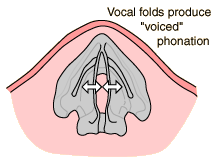Phonation
The process of speech production by the human voice may be divided into phonation, resonation, and articulation. Phonation is the process by which energy from the lungs in the form of air pressure is converted into audible vibrations.
 | One method of phonation involves using the air pressure to set the elastic vocal folds into vibration, a process called voicing. The other involves allowing air to pass through the larynx in to the vocal tract where modifications of the airstream produce transient or aperiodic sound waves. |
Aperiodic sounds can be combined with voiced sounds to create voiced consonants like /d/.
Voice concepts
Musical instruments